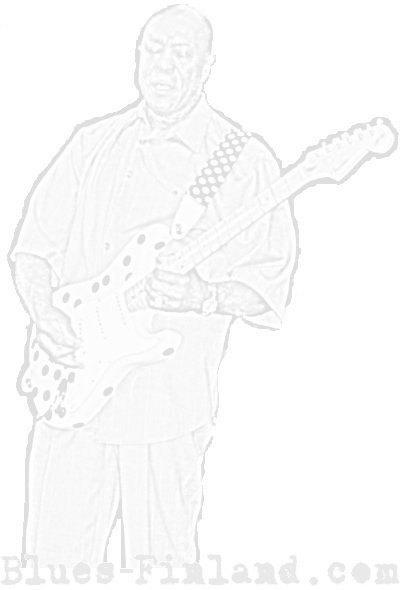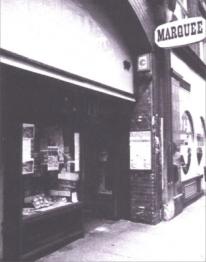 |
| Contact: admin (a) blues-finland.com © 2008 Blues-Finland.com |
| Muddy Waters At The Marquee Club, 12 November 1968 Published 11 September 2008 1968 was a momentous year. America was locked into a war in Vietnam while at home the Country was shaken by the assassinations of Martin Luther King and Robert Kennedy. Dissent was in the air and demonstrations in several western cities – notably Chicago and Paris - led to violent confrontations with police. In Czechoslovakia, Warsaw Pact tanks brutally suppressed the Dubcek Government’s dream of Liberalisation. To quote the ancient Chinese curse these were indeed “interesting times”, but to this 19-year-old blues lover the big news of the year was that Muddy Waters was coming to the UK. I had seen African American blues artists before of course, primarily on the AFBF package tours, but there, if a band was required, it was made up of artists on the bill regardless of whether their styles were truly compatible - as you can imagine, the results were sometimes indifferent. |
 |
| It was also felt by many fans that short individual sets coupled with the rather formal atmosphere of the concert hall venues didn’t allow the artists to perform to the best of their ability. Muddy’s visit though was different, his own band would accompany him, and I had a ticket to see them perform in London’s Marquee Club. I can still recall my eager anticipation as I made my way to Wardour Street in London’s Soho district. The rock band Free, described by the club as “a new addition to the list of Marquee blues attractions”, opened the show. Never a convincing blues band it must have been a difficult gig for them as Muddy attracted an audience of very knowledgeable, hard-core blues fans. Nevertheless they laid down an enthusiastic set – perhaps too enthusiastic as it was cut short when drummer Simon Kirke split the head of his bass drum. Enter Muddy Then, with very little fanfare, the Muddy Waters Band took the stage. Supporting Muddy’s vocals and slide guitar were Otis Spann (piano), Luther Johnson and Pee Wee Madison (guitars), Paul Oscher (harmonica), Sonny Wimberley (bass) and S.P. Leary (drums). Spann of course was a long time member of Muddy’s band, and S.P. Leary was a veteran of Howlin’ Wolf’s great band but the other musicians were new to me. Once in tune the band opened with a warm-up instrumental, which wasn’t great. A slow blues followed and still something was wrong. During this number the problem became apparent when a seriously refreshed Leary fell backwards off his drum stool- it was turning into a bad night for drummers. As Leary left the stage, Muddy motioned to Luther Johnson to take over the drum chair. He introduced “Blow Wind Blow” and the evening caught fire. This was the deepest, toughest music I had ever heard. Other numbers played in that first set included “Long Distance Call”, “Hoochie Coochie Man”, “Country Boy” and “Baby Please Don’t Go”. When Muddy left the stage, Pee Wee Madison closed the set with two numbers “The Woman I love” and BB King’s “Sweet Sixteen”. The second set opened with a rocking instrumental. S.P Leary was back on drums (I had to marvel at his powers of recuperation) and with Luther Johnson back on guitar we were able to enjoy the interplay between him and Madison. The band built on the impetus created in the first set with Muddy encouraging audience participation on “Mannish Boy” – no mean feat with an audience of formal Brits. This was followed with “Got My Mojo Working” and “She’s 19 Years Old” amongst others. Muddy’s last song of the evening was “Rolling Stone” which he performed as a duet with Otis Spann – just beautiful. Spann then closed the show with three unaccompanied numbers “Worried Life Blues”, “Look on Yonders Wall” and “Ain’t Nobody’s Business”. And then, with the music still ringing in my ears, it was out into Soho and a frantic rush to catch the last train home. A Superstar in His Prime Since that evening in 1968 I have seen many musical performances – some more memorable than others. A handful of these are permanently etched in my memory but the strongest memory by far is of this Muddy gig. As I typed the memoir I wondered why this should be, what was so special about that night? Perhaps the first thing that comes to mind was the visual impact that Muddy and his band had. The long hair and choreographed scruffiness of the young members of Free was in direct contrast with the sharp suits and shiny processed hair of Muddy’s men. Even Paul Oscher, the only Caucasian in the band, could have passed for a young business professional with his comparatively short hair and neat moustache. He even carried his harps in a leather doctor’s bag. As the band assembled onstage and tuned up, the familiar vocal accents of South London were replaced by those of black, Southside Chicago. All this combined to create – for me anyway - an air of mystique. On to the music and yet more contrast. It would be accurate, if unkind, to say that the Muddy Waters band played the blues, while Free played at the blues, and yet there was more to it than that; the basic approach was different. Most British blues-rock bands of the day placed a premium on instrumental virtuosity. Songs acted as a vehicle for extended improvisation and were probably chosen with this in mind rather than for their lyrical content. Their music, learned from records, was, in the words of author Stanley Booth, “A pastiche of often incompatible styles”, and it was played loud with an absence of dynamics. In this respect Free were no better or worse than many other bands. When Muddy stepped up to the microphone the atmosphere in the club changed. Anything you may have read about his “Regal” bearing is true; he was the star of the show and knew it. The band were there to play his music the way he felt it should be played and while they were all given the opportunity to show what they could do, their playing always enhanced the song. This was a large band - 3 guitars, piano, harp, bass and drums – in a small club, and yet the volume was never excessive. It was possible to hear the interplay between the musicians and appreciate the way they supported their leader. The quality of the ensemble playing gave the music a power and weight that can’t be achieved by volume alone, and on up-tempo numbers such as Blow Wind Blow and Got My Mojo Workin’, generated a massive swing that had the house rocking. Muddy himself was a powerful performer in those days, working hard at putting his songs across. His style was very direct, almost confrontational. He established eye contact with the audience and delivered the songs with total conviction no matter how trivial the lyrics. Occasionally he would emphasise a line or phrase with a gesture such as pointing, or wagging a finger or- even more sparingly – use the Preachers trick of repeating words or phrases for emphasis. His slide guitar solos were short, but to the point, and, as with those played by other band members, enhanced the song. There could be no doubt that here was a mature artist at the top of his game. I feel privileged to have been given the opportunity to listen. Muddy Waters At The Marquee: Coda On October 27 1968 the Muddy Waters Band appeared at the Copenhagen Jazz Festival. The performance was filmed and eight songs appear in the DVD “Muddy Waters Classic Concerts” distributed by Universal. The Concert Hall atmosphere seems to make the performances a little “stiff” but if you can imagine the band in a less formal club atmosphere then you will have some idea of the sound that captivated me in London one month later. STEVE LURY Additional reading Muddy Waters Biography Part 1 Muddy Waters Biography Part 2 Muddy Waters Biography Part 3 Why Muddy Waters? |
